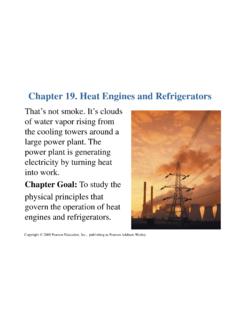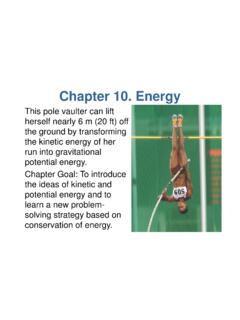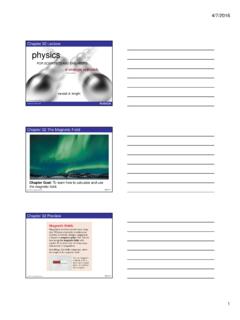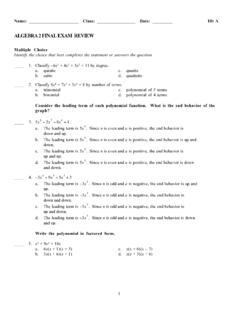Transcription of Formula: F coefficent of friction*m*g - Physics & Astronomy
1 ExamName_____MULTIPLE CHOICE. Choose the one alternative that best completes the statement or answers the the problem. (Use g = m/s2.)1)A 21 kg box must be slid across the floor. If the coefficient of static friction between the boxand floor is , what is the minimum force needed to start the box moving from rest?A)53 NB)106 NC)76 ND)205 N1)Formula: F = coefficent of friction*m*g2)A kg box slides down an inclined plane that makes an angle of 39 with the horizontal. Ifthe coefficient of kinetic friction is , at what rate does the box accelerate down the slope?A) m/s2B) m/s2C) m/s2D) m/s22)F = mgsin(angle); f = mu*m*g cos(angle); a = (F-f)/m = g (sin(angle)-mu*cos(angle))3)A skydiver reaches a "terminal velocity" of 120 km/h.
2 If the skydiver has a mass of kg,what is the magnitude of the upward force on the skydiver due to wind resistance?A) NB) NC)872 ND)959 N3)Upward force = mg since there is no )A driver in a kg car traveling at 37 m/s slams on the brakes and skids to a stop. If thecoefficient of friction between the tires and the road is , how long will the skid marks be?A)109 mB)70 mC)87 mD)81 m4)deceleration, a = mu*g; x = (v*v/2*a)5)A rescue plane spots a survivor 123 m directly below and releases an emergency kit with aparachute. If the package descends at a constant vertical acceleration of m/s2and theinitial plane horizontal speed was m/s, how far away from the survivor will it hit thewaves?A) kmB)436 mC)418 mD)296 m5)calculate t and then x using y = 1/2*a*t*t; x = v*t6)A robot submersible is released from a research vessel.
3 Through computer controls the craft isto execute the following sequence: a) a = i^ - j^ m/s2 for 24 s, b) maintain its velocity(no acceleration) for another min, and c) come to a full stop. How far from the vessel willit be located?A)1200 i^ - 1400 j^ mB)2100 i^ - 2400j^ mC)1200 i^ + 1400 j^ mD)1100 i^ - 1200 j^ m6)s = 1/2*a*t1*t1 + a*t1*t2; where a = acceleration vector, t1 = 24 s, t2 = sec (not min!)7)A boy throws a rock with an initial velocity of m/s at above the horizontal. How longdoes it take for the rock to reach the maximum height of its trajectory?A) sB) sC) sD) s7)t = v*sin(30deg)/g8)A cat leaps to catch a bird. If the cat's jump was at off the ground and its initial velocitywas m/s, what is the highest point of its trajectory?
4 A) mB) mC) mD) m8)t = v*sin(60deg)/g; y = v*t + 1/2*g*t*t19)A child is sitting on the outer edge of a merry-go-round that is 18 m in diameter. If themerry-go-round makes rev/min, what is the velocity of the child in m/s?A) m/sB) m/sC) m/sD) m/s9)v = omega*r = omega*d/2, where d = diameter = 2*r10)A satellite is in orbit around a planet. The orbital radius is km and the gravitationalacceleration at that height is m/s2. What is the satellite's orbital speed?A)10 m/sB)330 m/sC)33 m/sD)100 m/s10)v = square-root of (a*r)11)A 22 kg mass is connected to a nail on a frictionless table by a (massless) string of length the tension in the string is 51 N while the mass moves in a uniform circle on the table, howlong does it take for the mass to make one complete revolution?
5 A) sB) sC) sD) s11)Find omega from this: m*omega^2*r = tension, and use omega here: T= 2*pi/omega12)You are taking a turn at m/s on a ramp of radius m. What is your acceleration?A) m/s2B) m/s2C) m/s2D) m/s212)a = v^2/r13)An aircraft performs a maneuver called an aileron roll. During this maneuver, the plane turnslike a screw as it maintains a straight flight path, by using its ailerons to set the wings incircular motion. If it takes it 39 s to complete the circle and each wing length is m, what isthe acceleration of the wing tip?A) m/s2B) m/s2C) m/s2D) m/s213)omega = 2*pi/T; a = omega^2*r14)In an amusement park ride passengers stand inside an 8 m radius cylinder. Initially thecylinder rotates with its axis oriented along the vertical.
6 After the cylinder has acquiredsufficient speed, it tilts into a vertical plane, that is, the axis tilts into the horizontal, as shownin the figure. Suppose that , once the axis has tilted into the horizontal, the ring rotates onceevery s. If a rider's mass is 44 kg, with how much force does the ring push on her at the topof the ride?A)260 NB)430 NC)690 ND)1100 N14)F = m*omega^2*r, where omega = 2*pi/T15)Two boxes are sitting side by side on a frictionless surface. The box on the left has a mass of11 kg, and the box on the right has a mass of 17 kg. If a 28 N force pushes on the 11 kg boxfrom the left, what is the force exerted on the 17 kg box by the 11 kg box?A)17 NB)21 NC)11 ND)14 N15)This force gives acceleration to both: F = (m1+m2)a; F-F21 = m1*a; solve for F212 Solve the problem.
7 (Use g = m/s2.)16)A kg block on a table is connected by a string to a 63 kg mass, which is hanging over theedge of the table. Assuming that frictional forces may be neglected, what is the magnitude ofacceleration of the kg block when the other block is released?A) m/s2B) m/s2C) m/s2D) m/s216)a = m2*g/(m1+m2) from the equations: T = m1*a; m2*g-T = m2*a17)A 12 kg block on a table is connected by a string to a 26 kg mass, which is hanging over theedge of the table. If the 12 kg block is m from the edge of the table, how much time willpass before the block falls off the table from when the other block is released? Assume thatfrictional forces may be ) sB) sC) sD) s17)Find a using the same idea as in question #16, and use the equation of kinematics: x = 1/2*a*t^218)A piano mover raises a 100 kg piano at a constant rate using a frictionless pulley system, asshown below.
8 With roughly what force is the mover pulling down on the rope?A)1000 NB)2000 NC)500 ND)250 NE)Depends on the velocity!18)2*T = mg and T = mg/2319)The figure shows two packages that start sliding down a 20 ramp from rest a distanced = m along the ramp from the bottom. Package A has a mass of kg and a coefficient offriction Package B has a mass of 10 kg and a coefficient of friction How long does ittake package A to reach the bottom?A) sB) sC) sD) s19)Forces on A: Fa - fa + Fba = m1*a; Forces on B: Fb-fb-Fab = m2*a; Fba = -Fab (Newton's 3rdlaw)Fa = force down the plane for A = mg sin(theta), fa = frictional force = mu*m1*gcos(theta);d=1/2*a*t^220)The figure shows a block of mass m resting on a 20 slope. The block has coefficients of friction s = and k = with the surface.
9 It is connected via a massless string over a massless,frictionless pulley to a hanging block of mass kg. What is the minimum mass m that willstick and not slip?A) kgB) kgC) kgD) kg20)mg*sin(20deg) +mu*mg*cos(20deg) = 2kg*g21)A container explodes and breaks into three fragments that fly off 120 apart from each other,with mass ratios 1:4:2. if the first piece flies off with a speed of m/s, what is the speed of theother two fragments? (All fragments are in the plane.)A) and m/sB) and m/sC) and m/sD) and m/s21)Hint: use the principle of conservation of momentum along x- and )A kg baseball is thrown with a velocity of m/s. It is struck with an average force N, which results in a velocity of m/s in the opposite direction.
10 How long were thebat and ball in contact?A) x 10-3 sB) x 10-2 sC) x 10-2 sD) x 10-3 s22)F*t = momentum change; t = momentum change/F23)A golf ball of mass kg has a velocity of 102 m/s immediately after being struck. If the cluband ball were in contact for ms, what is the average force exerted on the ball?A) kNB) kNC) kND) kN23)use the same formula as in 2224)A kg pool ball moving in the +x direction collides with another pool ball. The collisionlasts 50 ms, and the average impulsive force on the first ball is -12 i^ + j^ N. If the initialvelocity of the first pool ball is m/s, what is the magnitude of its velocity after the collision?A) m/sB) m/sC) m/sD) m/s24)vf = (Ft + m*vi)/m, where vi = initial velocity vector = 50 i^425)A 1200 kg cannon fires a kg cannonball at 37 m/s.








